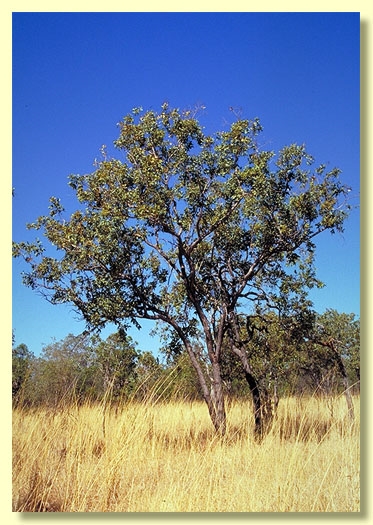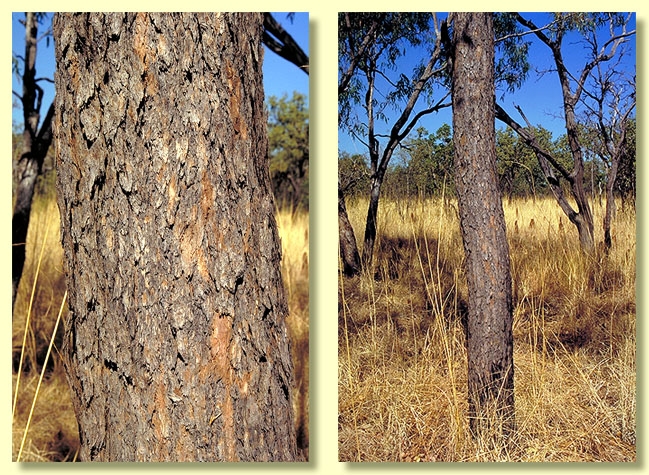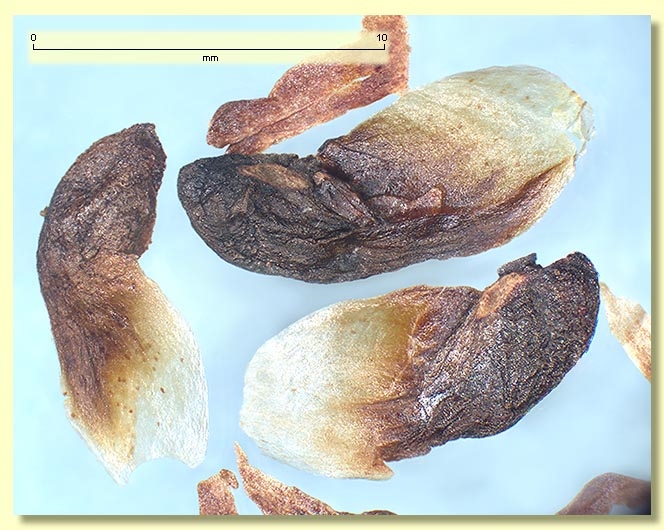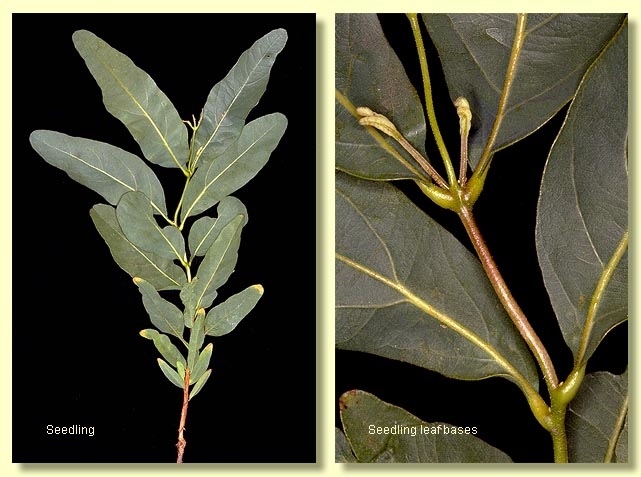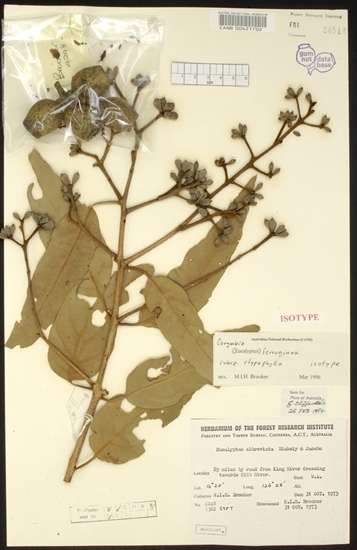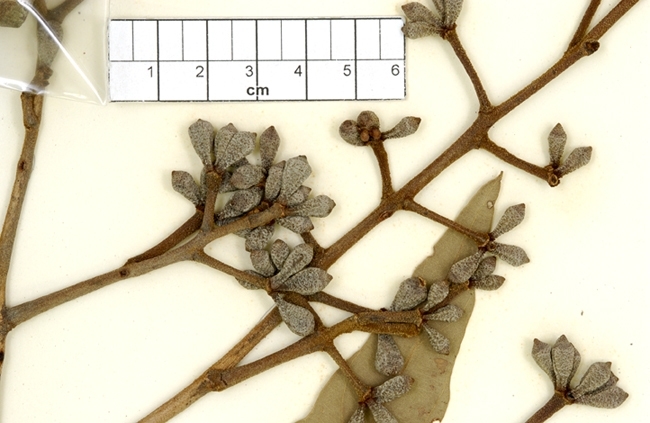Corymbia | Rufaria
Euclid - Online edition
Corymbia ferruginea subsp. stypophylla
Corymbia ferruginea subsp. stypophylla K.D.Hill & L.A.S.Johnson, Telopea 6: 343 (1995).
Eucalyptus stypophylla (K.D.Hill & L.A.S.Johnson) M.I.H.Brooker & D.A.Kleinig, (2004), Field Guide to Eucalypts. Volume 3, Northern Australia Edn. 2.: 109, 372. T: Western Australia: 89 miles [142 km] by road from King River crossing towards Gibb River, M.I.H.Brooker 4248, 31 Oct. 1973; holo: NSW; iso: CANB, PERTH.
Straggly tree 12 m tall. Forming a lignotuber.
Bark rough to small limbs, thick, tessellated to flaky, brown to grey-brown over pink.
Branchlets lack oil glands in the pith; younger branchlets scabrid, densely covered with reddish brown (ferrugineous) bristle-glands that have short radiating hairs.
Juvenile growth (coppice or field seedlings to 50 cm): not seen (subsp. ferruginea has stems rounded in cross-section, densely setose with short ferrugineous bristle-glands; juvenile leaves opposite, sessile to subsessile, elliptical to oblong, 6–14 cm long, (1.5)2.5–7 cm wide, the base stem-clasping to lobed, margin undulate, apex rounded and apiculate, rusty green, setose with bristle-glands.)
Crown of juvenile leaves, opposite, rarely a few sub-opposite, petiolate, petioles (0.5)0.8–2.6 cm long; blade usually broadly lanceolate to ovate, (5.4)7–21.5 cm long, 2–6(7.5) cm wide, undulate, base tapering to petiole or truncate to rounded, sometimes lobed, margin usually entire, apex pointed or rounded and ± apiculate, concolorous, dull or weathering slightly glossy, green but brown near main veins, scabrid with short rusty bristle-glands (in some populations scabridity obvious only on newest expandings leaves), side-veins at a wide angle to the midrib and widely spaced, looping to form intramarginal vein, reticulation very dense, oil glands apparently absent.
reticulation very dense, intramarginal vein present, oil glands apparently absent from the venation pattern.
Inflorescence terminal compoundand prominently branched with rhachis internodes and peduncles very densely clothed in bristle-glands that are hairy and rusty brown, peduncles rounded to angular, 1–3.5 cm long, buds 7 per umbel, usually shortly pedicellate (pedicels 0–0.5 cm long). Mature buds obovoid to pyriform, 0.7–0.8 cm long, 0.6–0.7 cm wide, setose and whitish scurfy, scar absent (both opercula shed together at flowering), operculum shallowly rounded, sometimes apiculate also, stamens inflexed, all fertile, anthers versatile, dorsifixed, oblong, dehiscing by longitudinal slits, style long and straight, stigma blunt and papillose (mop like), locules 4, with 5 or 6 vertical ovule rows on each placenta. Flowers pale creamy white.
Fruit sessile or pedicellate (pedicels 0–0.5 cm long), urceolate with a short erect neck or lacking this, 1.8–3.3 cm long, 1.5–2.9 cm wide, longer than wide, surface slightly rough, disc descending vertically, valves 4, enclosed.
Seeds brown, 9–15 mm long, ellipsoidal with terminal wing, hilum ventral.
Cultivated seedlings (measured at ca node 10): cotyledons large, reniform; stems rounded in cross-section, densely setose with rusty bristle-glands; leaves always shortly petiolate (petioles to 0.6 cm), opposite at least until node 15, elliptical to oblong or lanceolate, 3–12.5 cm long, 1.5–3.5 cm wide, base rounded or tapering, dull, green, ± concolorous, setose with rusty bristle-glands that bear short simple hairs on sides.
Flowering has been recorded in January, February, March and April.
Corymbia ferruginea is a bloodwood tree species found in woodlands from the central Kimberley region of Western Australia through the Top End of the Northern Territory to far north-west of Queensland, and on some islands in the western Gulf of Carpentaria. It is characterised by its extensive rough tessellated bark, crown of opposite, often undulate leaves, highly branched terminal inflorescences, and large fruit. The young branchlets and newly formed leaves, inflorescence internodes and buds are all densely covered with bristle-glands (setae) that are adorned with many simple short brown hairs giving a rusty appearance. As leaves in the crown age they weather to become less noticeably hairy but usually still feel rough.
The presence of rust-coloured "stellate" hairs is a feature shared with only one other eucalypt, C. abbreviata, in which they are restricted to the branches (internodes) within the inflorescence and absent from buds and crown leaves. Also the inflorescence of C. abbreviata is much reduced in size, compared with C. ferruginea, and its buds are pink-red and smooth. The geographic range of C. abbreviata is within that of C. ferruginea. There are two subspecies of C. ferruginea:
C. ferruginea subsp. ferruginea
Is largely confined to the monsoonal Top End on the Northern Territory including Elcho Island and the Wessel Islands of north-east Arnhem Land, extending into the north of Western Australia north of Wyndham, and into Queensland west of Burketown, also on Groote Eylandt and Maria Island in the Gulf of Carpentaria. It occurs on sandy to gravelly sites. The crown leaves are sessile or shortly petiolate (petioles to ca 0.5 cm long) with the base of the leaf usually stem-clasping or lobed and the majority of leaves wider than in subsp. stypophylla.
C. ferruginea subsp. stypophylla
Is found in seasonally drier, more inland areas, from Kurunjie, Mornington and Gibb River area of the central Kimberley Region of Western Australia east across the northern fringe of the Tanami Desert to Renner Springs in the Northern Territory. It differs from subsp. ferruginea in having strongly petiolate (petioles 0.5–2.6 cm long) crown leaves with lobed, rounded to truncate or tapering leaf bases. Plants in the Mornington area have rusty bristle-glands only on the youngest soft stems and newest leaf growth and are quickly lost with age.
Plants morphologically intermediate between the two subspecies occur in some areas, e.g. Timber Creek, Daly Waters to Renner Springs, and Mainoru in the Northern Territory. These usually have crown leaves with petioles ca 0.5 cm long.
MORE ABOUT CORYMBIA
MORE ABOUT RED BLOODWOODS
Eucalyptus ferruginea: Latin ferrugo, iron rust.
subsp. stypophylla: Greek stypos, a stalk and phyllon, a leaf.

